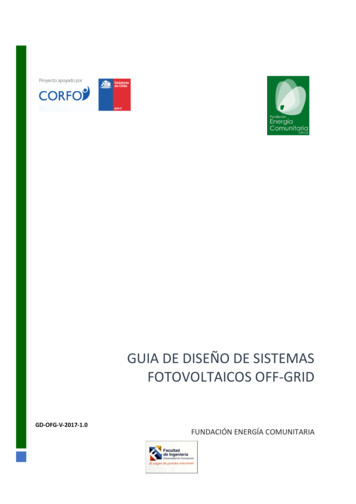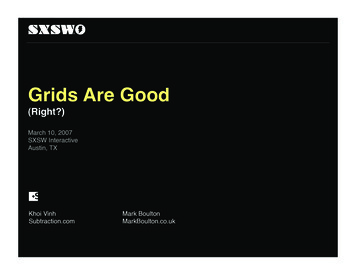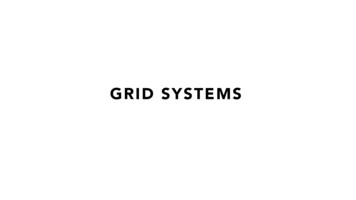
Transcription
SSDMATERIALCONTENTSForeword xiiiGHAcknowledgments xviiTEJames H. Gilmore and B. Joseph Pine IIThe Authors xixRIIntroduction 1PYPART ONE: 2 2 THINKINGCO1 The DNA of Great Problem Solving 92 Form, Method, and Mastery: 2 2 Thinking as Dialectical Process 243 The Eight Archetypal Dilemmas 37PART TWO: 2 2 PRACTICE4 Designing 2 2 Matrices: Making Intuition Explicit 615 2 2 Thinking in Action: Fujitsu FTXS Tackles Level 2 Dilemmas 69ix
x CONTENTSPART THREE: 2 2 FRAMEWORKS INVENTORY6 Strategic Frameworks 91Beyond Customer Led 95Discontinuity and the Life Cycle 99Customer as Value Manager 105Customer Value Analysis 107Scenarios 115Gartner Magic Quadrant 121Portfolio Analysis 125Problems and Solutions 127Dialectical SWOT Analysis: Strengths, Weaknesses,Opportunities, and Threats 129Market Tipping 131Corporate Strategy 134Generic Strategy 139E-Business Opportunity Matrix 144Global Product Planning 146Generic Network Strategy 148Mass Customization: The Four Approaches 151Attentionscape 156Managing Customer Loyalty 158Likelihood to Buy 161Revenue and Profitability 163BCG: Product Portfolio Matrix 169Impact-Uncertainty Matrix 173Entrance and Exit Strategies 1777 Organizational Frameworks 180Good to Great Matrix of Creative Discipline 184Employee Motivation 188Alliance Drivers 190Team Types 193Situational Leadership 195The Four Power Players in Knowledge Organizations 199T-Group Leadership 202SECI 204Human Capital 210Differentiation and Integration 215Means and Ends 219The Change Grid 221Learning and Change 223
CONTENTSSimilarities and Differences 225The Four Realms of Experience 228Make versus Buy 233Four Square Model 236Product and Supply Chain Architecture 238Telematics Framework 244The Virtue Matrix 2468 Individual Frameworks 250Johari Window 255Myers-Briggs Type Indicator 261Learning Styles Inventory 267I’m OK, You’re OK: The Four Life Positions 269Conflict Mode 271Social Styles 274Getting It Right 279Leadership Coaching 281Career Transitioning 283Prisoner’s Dilemma 286Urgency and Importance 290Influence and Concern 292Notes 295Index 303xi
Lowy.c063/15/049:57 AMPage 169STRATEGIC FRAMEWORKS Step 3: Monitor progress on a quarterly or monthly basis to measure success. Implement corrective actions if results are unacceptable.These are the steps for portfolio modeling: Step 1: Define. Place each of the businesses on the matrix, positioningthem in the appropriate quadrant. Step 2: Diagnose. Stepping back from the matrix, reflect on the currentmix, considering such factors as overall balance, profitability and return on capital, diversity, interdependencies, competency development, and investment innew, future sources of profit. Step 3: Envision. Adjust the mix to reflect a strong current and future setof businesses. Step 4: Follow up. Monitor to ensure that the businesses perform asplanned and continue to represent the values ascribed to them.ReferenceSlywotzky, A., and Morrison, D. The Profit Zone: How Strategic Business Design WillLead You to Tomorrow’s Profit. New York: Times Business, 1997.BCG: Product Portfolio MatrixBruce HendersenThe framework is simple on the surface, but has a lot of hidden depth. It’s whenyou get into the depth that you discover both its power and flexibility.—Simon Trussler40Mention “2 2 matrix” to someone in a business context, and more often thannot, that person will think of the BCG Grid. The names of the four quadrants—Dogs, Stars, Problem Children, and Cash Cows—have become standard popular terms and a convenient shorthand in strategic discussions. What has madethe framework so powerful and enduring is its amazing breadth; not only is ita method for structuring strategic priority-setting discussions, it also representsa business typology, making it possible for planners to think about a portfolioof holdings from an investment perspective.BCG founder Bruce Hendersen created the Product Portfolio matrix (Figure6.35) in the early 1970s to assist conglomerate organizations to analyze the relative worth of their different business units, subsidiaries, and products. Not onlydid it help to establish BCG as a leader in the strategy consulting domain, it169
Lowy.c063/15/049:57 AMPage 170170 THE POWER OF THE 2 2 MATRIXFigure 6.35. BCG Product Portfolio Matrixplayed an important role in defining and legitimizing strategy as a managementdiscipline practiced by professionals and consultants.The Two Dimensions and Their Extremes. The framework combines quantitative and intuitive features to produce an accurate and consensual picture ofthe investment worthiness of different business holdings. Each business unit isassessed with respect to its market (Market Growth) and then compared to theother business units owned by the conglomerate firm (Relative Market Share).Relative Market Share and Market Growth form the basis for analysis:Market Growth. Market Growth serves as a proxy for cash requirement. Amarket that is expanding rapidly requires more investment to maintain acompetitive position.Relative Market Share. Relative Market Share is a proxy for cost competitiveness and is derived from an essential BCG concept, the ExperienceCurve, which calculates the costs of production as a function of learningand size. Relative Market Share is determined by dividing the percentageof market held by a firm by the percentage held by its largest competitor.The Four Quadrants. The portfolio approach brings rationality to the businessinvestment process. Business units and markets proceed through a predictablecycle of maturation, which needs to be factored into decision making: Upper left: Stars. These are the high fliers—businesses with a high relativemarket share in a growing market. However, they still require investment to
Lowy.c063/15/049:57 AMPage 171STRATEGIC FRAMEWORKSmaintain market share, so they might not be as profitable as Cash Cows. Theymight even need more investment than they return in profit (resulting in a shortterm net loss). But these will be tomorrow’s Cash Cows providing market shareis maintained. Lower left: Cash Cows. The darling of the aging executive and owner alike,these businesses have high market share in a market with low growth. Maintaining current operations becomes the main cash requirements for this maturebusiness. Like a great wine or cheese, it has cellared sufficiently and is ready tobe harvested for profits as cash flow remains positive. Lower right: Dogs. Dogs are businesses with low market share in lowgrowth markets. The market may or may not be in decline. Despite the temptation to divest, dogs can have significant advantages, depending on marketconditions. For example, the market might be positioned to grow, redefiningpotential worth. Or the business might be cash flow positive and capable ofbeing restructured to maintain positive cash flow for a significant length of time.The business might also have significant strategic or brand importance, meriting retention to fend off competitors as a “guard dog.” Upper right: Question Marks (or Problem Children). These businesses compete in high-growth markets, but they have a relatively low market share andmay need significant investment to improve their position. Consultants tend tolike clients who own a few of these (and the pockets to pay fees), as carefulanalysis is needed to determine if it is best to invest more, sell the business, orreposition to focus on a specific market niche (among other options).Example: Dow versus Monsanto. “In the 1960s and early 1970s,” write GeorgeStalk and Thomas Hout, “a classic portfolio battle was waged by Dow Chemical against Monsanto. In this battle, Dow actively managed its portfolio foradvantage, and Monsanto did not.”41Firms that reinvest based on profitability alone risk overspending on maturebusiness lines while under-funding those in early stages of growth. It was notuncommon in the 1960s, however, for large multi-business companies to approach the market with a profit center orientation that did exactly this. Companies like GE and Westinghouse were leading practitioners of the strategy,promoting business unit accountability and rewarding financial results withindependence and growth capital. During this period, Dow approached the market with the portfolio strategy reflected by the BCG Grid, while rival Monsantopursued the prevailing profit center approach (Figure 6.36).Monsanto began the period with the stronger portfolio. Seven of its businesses were facing growth in demand greater than 20 percent, as compared withDow, which had only two businesses in this position. Following a course of reinvesting based principally on proven success and profitability, Monsanto overlooked emerging trends and opportunities. Of fourteen businesses growing at171
Lowy.c063/15/049:57 AMPage 172172 THE POWER OF THE 2 2 MATRIXFigure 6.36. Dow versus Monsanto Matrixan annual rate of 15 percent or greater, it expanded only three of those businesses faster than demand. It lost ground to competitors in eleven of fourteengrowing areas. Dow, in contrast, pursued strategic growth in the portfolio-basedmanner, investing boldly according to plan. Of the twenty-three growing businesses in its portfolio, twenty of them were expanding faster than demand. Confident in its business direction, Dow borrowed to grow, secure in the belief thatwell-planned debt constituted less risk than underinvestment. Dow’s debt-toequity ratio stood at 1.1:1 as compared with the much smaller 0.46:1 ratio atMonsanto.Through this period, Dow’s business grew steadily, while Monsanto’s stagnated. In portfolio management terms, Monsanto overspent on nongrowth businesses and failed to invest in launching a robust set of new Stars for futureprofitability. It wasn’t until 1981 and the efforts of CEO Dick Mahoney that Monsanto tackled its portfolio imbalances, leading the company back to a path ofstrategic growth and more respectable returns on equity.Context. The BCG matrix is used for analysis and to support strategic decisionmaking. Because of the need for data-based calculations to map the locationsof each business onto the 2 2 grid, it is seldom used during workshops forbrainstorming new ideas and concepts. This is a persuasive tool that can beused to gain group consensus around the findings of an analysis.Method. The following steps provide a high-level blueprint for conductingProduct-Portfolio analysis:
Lowy.c063/15/049:57 AMPage 173STRATEGIC FRAMEWORKS Step 1: Set the scope. Determine the unit of analysis by deciding whetherbusiness units, subsidiaries, product categories, or products are to be analyzed. Step 2: Define the portfolio. Collect the list of businesses held by the company in question for the agreed-upon units of analysis. Step 3: Calculate revenues. For each business within the list, gather the following pieces of information:Sales (revenue) numbers for the current year and for the past several years(two years minimum).For every competitor being analyzed, calculate sales (revenue) numbers forthe current year and for the past several years (two years minimum). Step 4: Calculate Market Growth and Relative Market Share. Find or calculate the Market Growth rates for each business being analyzed: This year’sindustry revenues Last year’s industry revenues/Last year’s industry revenues 100 percent. Calculate the Relative Market Share by dividing the firm’s(or business unit’s) market share (revenues may be compared) by that of itslargest rival. Step 5: Complete the grid. Plot each item on the grid based on the calculated values for Market Share and Market Growth, and analyze the results.ReferencesStalk, G. Jr., and Hout, T. M. Competing Against Time. New York: Free Press, 1990.Stern, C. W., and Stalk, G. Jr. Perspectives on Strategy. New York: Wiley, 1998.Impact-Uncertainty MatrixAdapted by William RalstonThe quest for certainty blocks the search for meaning. Uncertainty is the verycondition to impel man to unfold his powers.—Erich Fromm42For the past thirty years, the Impact-Uncertainty matrix (Figure 6.37) has beenone of SRI Consulting Business Intelligence’s (SRIC-BI) most widely used andeffective tools for analyzing the external environment. It is applied in scenarioplanning, strategy management, issues scanning, and technology planning. Thetool’s key benefit is that it focuses management’s attention on the most important external issues that drive future threats and opportunities.An Impact-Uncertainty exercise begins by focusing on corporate decisions thatmay be greatly affected by changes in the external environment. These external173
Dialectical SWOT Analysis: Strengths, Weaknesses, Opportunities, and Threats 129 Market Tipping 131 Corporate Strategy 134 Generic Strategy 139 E-Business Opportunity Matrix 144 Global Product Planning 146 Generic Network Strategy 148 Mass Customization: The Four Approaches 151 Attentionscape 156 Managing Customer Loyalty 158 Likelihood to Buy 161 Revenue and Profitability 163 BCG: Product .











